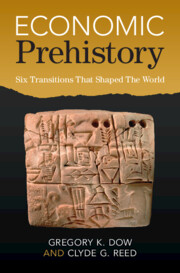Book contents
- Economic Prehistory
- Economic Prehistory
- Copyright page
- Dedication
- Contents
- Figures
- Tables
- Preface
- Acknowledgments
- Abbreviations
- Part I Prologue
- Part II Sedentism and Agriculture
- Part III Inequality and Warfare
- 6 The Transition to Inequality
- 7 Warfare between Egalitarian Groups
- 8 Warfare between Elite Groups
- Part IV Cities and States
- Part V Epilogue
- References
- Author Index (Abridged)
- Subject Index
6 - The Transition to Inequality
from Part III - Inequality and Warfare
Published online by Cambridge University Press: 10 February 2023
- Economic Prehistory
- Economic Prehistory
- Copyright page
- Dedication
- Contents
- Figures
- Tables
- Preface
- Acknowledgments
- Abbreviations
- Part I Prologue
- Part II Sedentism and Agriculture
- Part III Inequality and Warfare
- 6 The Transition to Inequality
- 7 Warfare between Egalitarian Groups
- 8 Warfare between Elite Groups
- Part IV Cities and States
- Part V Epilogue
- References
- Author Index (Abridged)
- Subject Index
Summary
This chapter constructs a theory about the origins of inequality. Our model involves a continuum of sites that have differing productivities with respect to food. All sites are initially open, and free mobility of agents across sites tends to equalize the food incomes of the agents. However, an organized group that is large enough relative to the land area of a site can establish property rights over that site and keep other agents from entering. As climate or technology improves, population densities grow, and over time the best sites become closed. This generates insider–outsider inequality, where different groups have different standards of living depending on the productivities of their sites. Eventually insiders at the best sites find it profitable to hire outsiders to work on their land, either by paying them a wage or requiring them to pay land rent. This gives elite–commoner inequality, or stratification. Class positions become hereditary. Technical progress makes commoners worse off in the long run because as regional population rises, more sites are closed. The sites that remain open are the least desirable. These predictions are consistent with archaeological evidence from southwest Asia, Europe, Polynesia, and the Channel Islands of California.
Keywords
- Type
- Chapter
- Information
- Economic PrehistorySix Transitions That Shaped The World, pp. 217 - 271Publisher: Cambridge University PressPrint publication year: 2023

